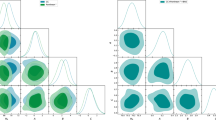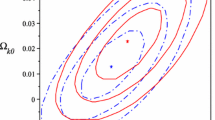Abstract
Generalised Teleparallel gravity, also referred to as f(T) gravity, has been recently proposed as an extended theory of gravitation able to give rise to an accelerated expansion in a matter only universe. We focus on two particular choices for f(T) and we check their viability contrasting the predicted background dynamics to the Hubble diagram as traced by both Type Ia Supernovae (SNeIa) and Gamma Ray Bursts (GRBs), the measurement of the rate expansion H(z), the Baryon Acoustic Oscillations (BAOs) at different redshifts, and the Cosmic Microwave Background Radiation (CMBR) distance priors. Both f(T) models turn out to be in very good agreement with this large dataset so that we also investigate whether it is possible to discriminate among them relying on the different growth factors.
Access provided by Autonomous University of Puebla. Download conference paper PDF
Similar content being viewed by others
Keywords
- Cosmic Microwave Background Radiation
- Background Dynamic
- Teleparallel Gravity
- Baryon Acoustic Oscillation
- Full Likelihood
These keywords were added by machine and not by the authors. This process is experimental and the keywords may be updated as the learning algorithm improves.
1 Introduction
The discovery of the acceleration of the universe through the SNeIa Hubble diagram has been latter confirmed by wide range of data, from more recent SNeIa data to BAOs and CMBR anisotropies. On the other hand, such overwhelming abundance of observational evidences in favour of the cosmic speed up does not fit in the framework of General Relativity (GR) making clear that out theoretical background is seriously flawed.
In as much the same way as for f(R) theories, one can obtain a generalised teleparallel gravity replacing T with a generic function f(T) thus opening the way to a rich phenomenology. A particular important consequence is the breakdown of the equivalence with the classical GR with the two theories now predicting a radically different dynamics [1]. Modified teleparallel gravity preserves the advantage of giving equations that are still second order in field derivatives opposite to the fourth order equations deduced in f(R) gravity thus avoiding unpleasant pathologies. On the other hand, it suffers from the lack of Local Lorentz Invariance (LLI) so that all the 16 components of the vierbien are independent and one cannot simply fix 6 of them by a gauge choice [2].
A critical role in generalised teleparallel theories is played by the choice of the functional expression for f(T). The lack of firmly established theoretical constraints leaves open the way to a wide range of possibilities which can only be validated a posteriori, i.e. by contrasting their predictions with the observational data. This is the aim of the present work where we focus our attention on two particular classes able to give rise to a phantom-like behaviour of the effective torsion fluid.
There are actually almost no theoretical hints on the functional form of f(T) with, on the contrary, many possible expressions leading to an accelerated expansion.Two recently proposed model of this kind can be obtained setting [3]
where the subscript 0 denotes present day quantities.
We then test these two models against SNeIa + GRB Hubble diagram, H(z) measurements from cosmic chronometers, BAOs data and the CMBR distance priors. Although wide, the present dataset only traces the background expansion so that we will also investigate whether further insight into the properties of these models can be obtained by the analysis of the growth factor being this latter a quick way to look at how perturbations evolve in the proposed modified teleparallel scenarios.
2 f(T) Models Versus Data
In order to answer the question whether f(T) gravity can reproduce the observed Universe, we will explore the model parameter spaces by investigating the following likelihood function
The first term refers to the Hubble diagram, i.e. the distance modulus μ as function of the redshift z. While SNeIa and GRBs probe the distance-redshift relation as standardizeable candles, Baryon Acoustic Oscillations (BAOs) work as standard rulers. We therefore add the term \(\mathcal{L}_{\mathit{BAO}}\) to the full likelihood following the method detailed in [4]. The last term in the likelihood finally refers to the WMAP7 distance priors which have been recommended as a quick and efficient way to include the CMBR constraints without computing the full anisotropy spectrum. The observable quantities are the redshift z ⋆ to the last scattering surface the acoustic scale \(\ell_{A} =\pi r(z_{\star })/r_{s}(z_{\star })\) and the shift parameter \(\mathcal{R}\).
In order to efficiently explore the parameter space, we use a Markov Chain Monte Carlo (MCMC) code running multiple chains and checking the convergence through the Gelman–Rubin criterium. The best fit parameters will be the ones maximizing the full likelihood, but the most reliable constraints on each single parameter p i are obtained by marginalizing over all the parameters but the i-th one.
3 Results and Conclusions
The best fit parameters and marginalized constraints for the tanh and exp model are given in Tables 1 and 2, while Fig. 1 shows the remarkable agreement among the best fit models predictions and the SNeIa + GRB Hubble diagram and H(z) data. The overall good quality of the fit may be further appreciated by comparing the model predictions for the BAO and CMB quantities with the observed values.
Having been designed to give an accelerated expansion, the parameter space of both models collapses into a region giving rise to a background dynamics similar to the ΛCDM one. As a consequence, the two models can be hardly discriminated based on the dataset we have used. It is worth stressing that this is not a limitation of the data, but rather an intrinsic feature of how the models have been worked out. As such, improving the precision of the measurements or increasing the statistics does not help in discriminating among the f(T) models and the ΛCDM one. On the contrary, one has to resort to different tracers which are related to the evolution of the perturbations, the simplest one being the growth factor g(z). On small scales, the impact of torsion only introduces a redshift dependent rescaling of the gravitational constant which now becomes \(G_{\mathit{eff }} = G/(1 + f_{T})\). On the largest scales, the torsion field modifies the growth of perturbations by altering both the gravitational constant and the friction term. As a consequence a richer phenomenology is achieved possibly leading to other ways to discriminate among f(T) models and dark energy ones. Two candidate probes are the matter power spectrum P(k) and cosmic shear and deserve a detailed analysis to a forthcoming publication.
This contribution is based on [5].
References
R. Ferraro, F. Fiorini, Phys. Rev. D 75, 081031, 2007; R. Ferraro, F. Fiorini, Phys. Rev. D 78, 124019, 2008; F. Fiorini, R. Ferraro, Int. J. Mod. Phys. A 24, 1686, 2009
B. Li, T.P. Sotiriou, J.D. Barrow, Phys. Rev. D 83, 064035, 2011
P. Wu, H. Yu, Eur. Phys. J. C 71, 1552, 2011
C. Blake, E.A. Kazin, F. Beutler, T.M. Davis, D. Parkinson, et al., MNRAS 418, 1707, 2011
V.F. Cardone, N. Radicella and S. Camera, Phys. Rev. D 85, 124007, 2012
Author information
Authors and Affiliations
Corresponding author
Editor information
Editors and Affiliations
Rights and permissions
Copyright information
© 2014 Springer-Verlag Berlin Heidelberg
About this paper
Cite this paper
Radicella, N., Cardone, V.F., Camera, S. (2014). Accelerating f(T) Gravity Models Constrained by Recent Cosmological Data. In: García-Parrado, A., Mena, F., Moura, F., Vaz, E. (eds) Progress in Mathematical Relativity, Gravitation and Cosmology. Springer Proceedings in Mathematics & Statistics, vol 60. Springer, Berlin, Heidelberg. https://doi.org/10.1007/978-3-642-40157-2_54
Download citation
DOI: https://doi.org/10.1007/978-3-642-40157-2_54
Published:
Publisher Name: Springer, Berlin, Heidelberg
Print ISBN: 978-3-642-40156-5
Online ISBN: 978-3-642-40157-2
eBook Packages: Mathematics and StatisticsMathematics and Statistics (R0)





